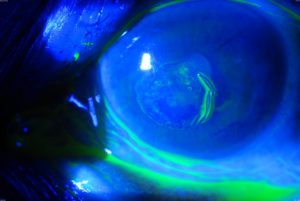Recurrent Corneal Erosions
Recurrent corneal erosions are episodes of eye pain due to abnormalities of the surface layer of the cornea (epithelium) that causes it to be poorly adherent to the rest of the cornea.
Call Us: 215-928-3180
Recurrent corneal erosions are episodes of eye pain due to abnormalities of the surface layer of the cornea (epithelium) that causes it to be poorly adherent to the rest of the cornea.
Call Us: 215-928-3180
 The surface layer of the cornea (epithelium) is supposed to be well attached to the body of the cornea (stroma).
The surface layer of the cornea (epithelium) is supposed to be well attached to the body of the cornea (stroma).
In some eyes, often after trauma to the cornea or in eyes with certain corneal dystrophies (especially epithelial basement membrane dystrophy or EBMD), but occasionally out of the blue, the surface layer separates from the body of the cornea causing pain. The pain may be fleeting or can last for hours or days, depending on how much of the surface layer separates and whether a corneal abrasion occurs.
Recurrent erosions generally respond to medical treatment with antibiotics and lubricants or a bandage soft contact lens. If unsuccessful, a variety of surgeries can be effective ranging from anterior stromal micropuncture, removal of the epithelium with or without diamond burr polishing of the stroma (see “Surgical Procedures” page), to excimer laser resurfacing (phototherapeutic keratectomy or PTK) (see “Surgical Procedures” page).
Recurrent corneal erosions are episodes of eye pain due to abnormalities of the surface layer of the cornea (epithelium) that causes it to be poorly adherent to the rest of the cornea.
Mild to severe eye pain that typically develops during the night or upon awakening, The pain may be fleeting or can last for hours or days, depending on how much of the surface layer separates and whether a corneal abrasion occurs.
Shearing type trauma to the eye (e.g. fingernail, paper or tree branch injury) or an underlying corneal dystrophy, most likely epithelial basement membrane dystrophy or less commonly other dystrophies such as Reis-Bucklers or lattice corneal dystrophies.
Eye trauma or family history of corneal dystrophy.
Corneal erosions can predispose to corneal infections which can cause corneal scarring and poor vison.
The diagnosis can usually be made by history and slit lamp examination with special dyes such as fluorescein.
Recurrent erosions generally respond to medical treatment with antibiotics and lubricants or a bandage soft contact lens. If unsuccessful, a variety of surgeries can be effective ranging from anterior stromal micropuncture, removal of the epithelium with or without diamond burr polishing of the stroma (see “Surgical Procedures” page), to excimer laser resurfacing (phototherapeutic keratectomy or PTK) (see “Surgical Procedures” page).
The key to prevention of future erosions is lubrication every night for at least 3-6 months.
